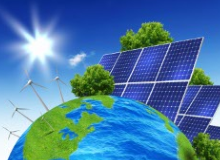Brief Analysis of the Energy Law (Draft for Comments)
2020.05.22 QIN, Yu (Bill)、DU, Lijing、LI, Yunhan
On April 10, 2020, the National Energy Administration (“NEA”) published the Energy Law of the People’s Republic of China (Draft for Comments) (the “Draft Energy Law”) in order to solicit public opinions. This article aims to briefly introduce the legislative background and highlights of the Draft Energy Law, look into its potential major impacts on China’s energy industry, and point out some deficiencies in the current draft.
I. Legislative Background
It has been 13 years since the first draft of the Energy Law of the People’s Republic of China was published for public comment in 2007. The legislative process was suspended from 2010 to 2015, due to the following factors (i) the energy industry touches upon so many different sectors which includes oil, gas, coal, thermal power and renewable energy, and the Energy Law, which is intended to serve as a high-level comprehensive legislation, would have to take into consideration the interests of all the various parties concerned; and (ii) there have been continuous energy system reforms in China during this period which must be examined through real practice before the relevant policies could be written into laws.1 In 2017, the NEA submitted to the former Legal Affairs Office of the State Council a draft Energy Law for review, and further formulated this recently published Draft Energy Law based on the previous draft.
It is worth noting that the Draft Energy Law was published by the law drafting authority (i.e. NEA). This means that the Energy Law is still in the drafting process and at a relatively early stage in the legislation process. Furthermore, the primary goal of the Draft Energy Law is more about the summarising and reinforcing of the reform experiences than to guide and lead the reforms. There are still several ongoing changes and reforms in China’s energy industry, for example, the separation of networks and operations in the oil and gas sectors, electricity marketization reform, green certificate trading, guaranteed consumption of renewable energy, and the gradual reduction of renewable energy subsidies. There are controversial voices inside the Ministry of Justice and also throughout the industry wondering whether it is indeed necessary to introduce the Energy Law at this stage2. In terms of the quality of the law draft, there are many deficiencies and controversies regarding the wording of the current Draft Energy Law. We expect that it still requires a substantial amount of time and effort before formal legislation takes shape.
II. Highlights
The Draft Energy Law is comprised of 117 clauses and divided into eleven charters: general provisions, energy strategy and planning, energy development, processing and conversion, energy supply and use, energy markets, energy security, advances in science and technology, international cooperation, supervision and administration, legal liabilities, and supplementary provisions.
Set out below are several highlights of the Draft Energy Law:
Establishment of a National Energy Strategy: Energy development and utilization shall be compatible with an ecological society. Concepts to do with innovative, coordinated, green, open and shared development shall be considered. Revolutions around consumption, supply, technology and institutions shall be promoted, and international cooperation shall be enhanced. The strategy emphasizes green, low-carbon and innovation-driven energy development, prioritising energy-saving and focusing on domestic development, with the goal of building a clean, low-carbon, safe and efficient energy system. (Article 3)
Giving priority to the development of renewable energy: The State shall adjust and optimize the energy industry and the consumption structure, giving priority to the development of renewable energy, safely and efficiently developing nuclear power, increasing the proportion of non-fossil energy, and promoting the clean and efficient use and low-carbon development of fossil energy. (Article 4)
Promoting Energy Marketization: Remaining committed to the decisive role of the market in the allocation of resources, the State shall build an effective competitive market structure and market mechanism, form a mechanism where the market determines the energy prices in a competitive field, and establish an effective energy regulatory system. (Article 14)
Guaranteed Consumption for Renewable Energy Generation: The State shall establish a guaranteed system for renewable energy consumption and stipulate the minimum proportional index of the renewable energy consumption undertaken by provinces, autonomous regions and municipalities directly under the Central Government in regard to social power consumption. Power supply and electricity sales enterprises and power users participating in market-based transactions shall complete the minimum proportion index of the region where they are located. Market players that do not complete the minimum proportion index may fulfill their obligations by purchasing quotas from those over-fulfilling their obligations in market-based transactions. (Article 45)
Dynamic Adjustment of Renewable Energy Subsidy Policy: The relevant departments under the State Council will adjust the subsidy policy for renewable energy generation according to the transaction situation. (Article 45)
Opening up pipeline networks: The fair access mechanism shall be improved for the power grid, oil and gas pipeline networks and other energy transmission pipeline network facilities, which shall be made accessible to eligible energy production and sales enterprises and other market players in accordance with the law without discrimination. No entity or individual may restrict market players from applying for access to the energy transmission pipeline network in accordance with the relevant provisions of the State. (Article 53)
Universal Service Obligations of Energy Supply Enterprises: Enterprises that supply such energy as electricity shall perform their corresponding universal service obligations in accordance with the relevant provisions of the State. The specific measures for compensation for universal energy services shall be formulated by the energy department under the State Council together with the finance department, the pricing department and the other relevant departments under the State Council and will be promulgated and implemented after being reported to and approved by the State Council. (Article 58)
Distinguishing natural monopoly businesses and competitive businesses: Natural monopoly businesses and competitive businesses in the energy sector shall be operated separately; various investors are encouraged to participate in energy development, utilization and infrastructure construction on an equal footing in accordance with the law. (Article 64)
International cooperation: The State shall protect the lawful rights and interests of foreign citizens, legal persons and other organizations involved in the energy development and utilization in China in accordance with the law. (Article 85)
Government’s on-site inspection powers: The energy department and other relevant departments may, for the purpose of fulfilling their legitimate duties, enter the production and operation premises of energy enterprises and energy users to perform on-site inspections, check, copy and inspect related documents and materials, and take custody of documents or materials that may otherwise be transferred, hidden or destroyed. (Article 97)
III. Major Impacts
1. Impacts on renewable energy consumption and green certificate trading
Since 2012, China's renewable energy market has entered a rapid expansion period. At the same time, consumption issues regarding hydropower, wind power and photovoltaic power have begun to appear. Although the Renewable Energy Law provides for a fully guaranteed offtake system for renewable energy power generation, the actual implementation of the system encountered many obstacles in terms of policy planning, industry monopoly and technology. Over the years, the National Development and Reform Commission ("NDRC") and the NEA have jointly issued several critical regulations in response to the issue of renewable energy consumption, including the minimum guaranteed off-taking hour system, the overall targets of renewable energy consumption for each region, the renewable energy power quota system, and the guaranteed renewable energy consumption system.
As a summary of successful market experiences, Articles 44, 45 and 48 of the Draft Energy Law make clear the renewable energy target system, the guaranteed renewable energy consumption system, and the renewable energy power generation priority grid connection system, which all mark the formal establishment of China's mandatory guaranteed renewable energy consumption system on the legislation level.
Article 45 of the Draft Energy Law stipulates that market participants that fail to fulfil the minimum renewable energy consumption obligations can purchase quotas from other market participants through market-based transactions. According to an NEA official during a press conference regarding the renewable energy guaranteed consumption system, the market participants could fulfil their minimum renewable energy consumption obligations through one of the two following ways: (i) the transfer of consumption volume, or (ii) the voluntary subscription of green certificates. While a transfer of consumption volume is applicable to all kinds of renewable energy, the ongoing practice of green certificate trading is limited to onshore wind power and photovoltaic power. The scope and pricing system of green certificate trading will be adjusted in accordance with the actual implementation of the guarantee consumption system.
With the policies regarding the gradual reduction of renewable energy subsidies and parity grid connection becoming clearer, the green certificate market has become more active. Some multinationals have turned their attention to China’s green certificate market. Since 2019, JunHe has represented a large well-known multinational in its green certificate related transactions in China and has provided continuous legal services in connection with the drafting and negotiation of environmental attributes purchase agreements and other transaction documents. We expect that with the implementation of the guaranteed renewable energy consumption system, the coordination between the green certificate trading market and the consumption volume trading market will be further specified. The market demand for green certificate trading will largely increase, and the market will become far more active in the near future.
2. Impacts on renewable energy subsidies
China’s current renewable energy subsidy system is provided in the Renewable Energy Law, i.e. the balance between the renewable energy on-grid electricity price and the average on-grid electricity price of conventional energy generation will be compensated by the national renewable energy development fund (also known as “national subsidy”). However, as the renewable energy market expands, the long-standing issues regarding deficits of funds and late payment of national subsidies worsen. Renewable energy companies are facing greater financial pressure.
To tackle the increasingly serious issues in subsidies, the government has adopted a schedule and roadmap of unsubsidized parity grid connection for photovoltaic and wind power projects in order to accelerate the de-subsidization process. However, for a huge number of stocked projects, the subsidy deficits remain large.
In this context, the Draft Energy Law does not propose a clear subsidy policy, but rather generally outlines that the subsidy policy will be dynamically adjusted according to the actual implementation of consumption volume trading. Article 45 and Article 46 of the Draft Energy Law stipulate that the relevant departments of the State Council will adjust the renewable energy power generation subsidy policy according to the trading situation, and the state will formulate the relevant fiscal, financial and price policies to support renewable energy development and use. These two clauses are relatively general and broad, and lack more detailed and practical rules.
We believe, on the one hand, that the currently available schedule of unsubsidized parity grid connection for photovoltaic and wind power projects represents one kind of dynamic adjustment scheme; on the other hand, for stocked photovoltaic and wind power projects and other renewable energy projects, the broad expressions of Articles 45 and 46 allow for more flexible policy implementation and institutional design. It also means that the form and intensity of renewable energy subsidies will very likely change in the future. Renewable energy companies should shift their thinking patterns as soon as possible and actively participate in market-based trading in order to become competitive in the long term.
3. Impacts on the pipe networks
(1) Promoting the separation of networks and operations
The Draft Energy Law clearly states that the natural monopoly business and competitive business in the energy industry should be operated separately, which has an important guiding role in the reform of the electricity networks as well as the oil and gas pipeline networks.
Taking oil and gas reform as an example, the oil and gas pipeline network is a natural monopoly business, and the production and sales of oil and gas are competitive businesses. The reform of the separation of networks and operations in the oil and gas industry is making real progress. In March 2019, Opinions on the Implementation of the Reform of the Operation Mechanism of Oil and Gas Pipeline Networks was released; in December 2019, the National Oil and Gas Pipeline Network Group was incorporated, highlighting the fact that the new system of oil and gas markets has been basically formed. The details of subsequent divestiture, asset transfers and operation modes need to be further studied and refined.
The industry believes that the Draft Energy Law will achieve greater cross-industry competition, which helps the rapid transplantation of the reform experience in different fields. For example, the power system reform can draw on the experiences of network separation reform in the oil and gas industry.3
(2) Guaranteeing fair access
While the monopoly of the pipeline network is allowed, the Draft Energy Law also strengthens the fair opening of the pipeline network to prevent operators from using their monopoly positions to infringe on the legitimate rights and interests of other enterprises and consumers.
The NDRC, the NEA and several other authorities jointly issued the Regulations on Fair Opening of Oil and Gas Pipeline Network Facilities in May 2019, which put forward specific requirements and regulatory measures of the fair opening of natural gas pipeline network facilities. ln December 2019, the NEA released the Measures for Fair Opening of Power Grids (Draft for Comment), proposing that the power grid should be open to all parties of power supply and grid interconnection in a fair and non-discriminatory way. The Draft Energy Law raises the requirements of the fair opening of the pipeline network to the legislation level for the first time, providing a legal basis and top-level guidance for the practice of the fair opening of the pipeline network.
(3) Escorting incremental power distribution networks
Traditionally, the power distribution business is a monopoly business. But with the continuous deepening of power system reform, the power distribution business has become a gradually liberalized competitive business. The incremental distribution business reform is one of the important parts of the power system reforms, which aims to encourage investors to fairly participate in the investment and construction of the distribution network.
Since the implementation of the incremental power distribution network pilot in 2015, the reform has entered a critical phase. The total number of pilot projects has exceeded 400. However, the development of the incremental power distribution business is still largely limited by the power transmission business of traditional power grid companies, and it is difficult for incremental power distribution companies to form their own competitiveness to compete with those traditional power grid companies. The Draft Energy Law specifically requires the separation of competitive businesses and monopoly businesses and imposes the requirements of fair access, which is of great significance to the development of the incremental power distribution business. Only when the power grid companies complete the separation of transmission and distribution businesses and the fair access of investors is guaranteed, the incremental power distribution companies could have equal rights in interconnection, construction and operation, and so enter a much fairer competition.
4. Impacts on independent electricity sales companies
As emerging market players since the reform of the power system, independent power sales companies generate profits by purchasing power from the wholesale market and then reselling it to end users. However, due to problems such as high wholesale prices, small profit margins, lack of data for accurate forecasting, and limited users active in the market, independent power sales companies have been at an inherent disadvantage when competing with power sales companies formed by power generation companies or power grid companies. Because it is rather difficult for a new market player like independent electricity sales companies to break the market monopoly on their own, their development is largely constrained.
The Draft Energy Law requires the separation of competitive and monopoly businesses, which we believe will help build a fairer electricity sales market environment and boost the development of independent electricity sales companies.
IV. Remarks and Deficiencies
On the positive side, this Draft Energy Law, which took more than ten years starting from the first draft in 2007, is a summary of China's reform experience in the energy sector and has significant meaning in terms of declaring reform achievements and summarizing the reform experience.
On the other hand, the provisions of the Draft Energy Law mainly focus on macro-policy and providing direction guidance, with few specific operational rules. There are many unclear provisions and issues need to be clarified in the subsequent legislative works, for example:
In terms of the issues regarding renewable energy subsidies and consumption that are of great concern to the industry, the current policies are still unclear. The operation mode of the existing renewable energy subsidies policy and the gradual reduction of subsidy policy are not clear, and the draft fails to provide adequate institutional support for green certificate trading;
In terms of the fair opening of the pipeline network, the draft only mentions fair access, but does not mention how to secure the fair use of the pipeline network;
The draft requires the power grid companies to develop energy storage technologies, which may conflict with market-oriented reforms and the requirement of the separation of natural monopoly businesses and competitive businesses;4
In terms of energy security, the current provisions focus on setting up the security obligations of energy companies, but do not elaborate on the responsibilities of government departments and other market players in the energy industry; and
In terms of energy supervision and administration mechanisms, the allocation of powers and authorities is still too general to provide a real solution to the coordination between the different government departments
[1] Zhan Shuguang, After thirteen years, what is the difference in Energy Law?, April 23, 2020.
[2] Gaoge, Multiple drafts in thirteen years, what kind of Energy Law do we need?, The Economic Observer, April 17, 2020; Chen Shouhai, How far is the Energy Law?, May 7, 2020.
[3] Zhan Shuguang, The Energy Law is open for public comments, which controversies have come to an end?, the China Energy, April 14, 2020.
[4] Tanyitan, Discussion of Proposed Changes to the Energy Law from Power Operation Perspective, Electricity Law Review, April 21, 2020.













